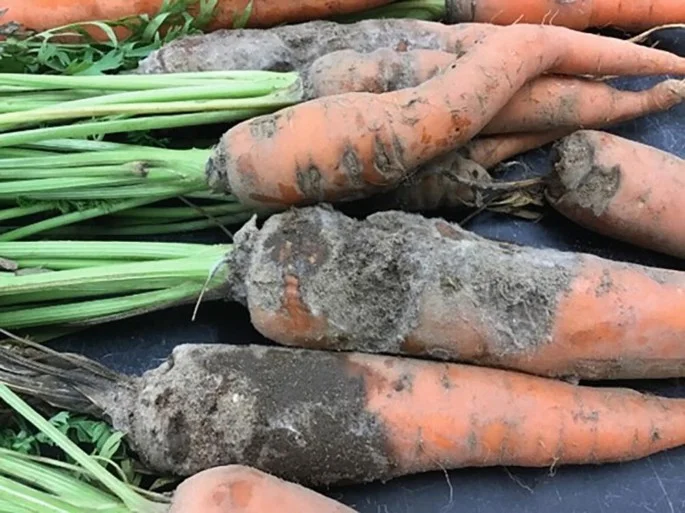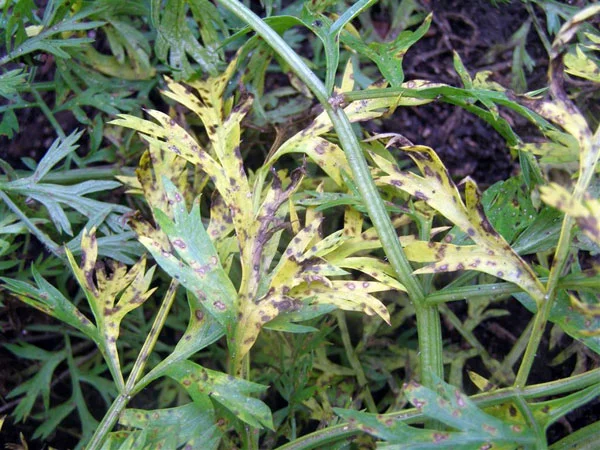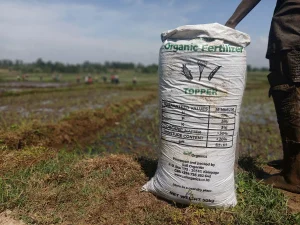
Carrots are a staple crop in many agricultural systems around the world, valued for their nutritional benefits, versatility, and economic importance. However, like all crops, carrots are susceptible to various carrot diseases that can significantly impact yield and quality.
For farmers, understanding these diseases is crucial not only for maintaining healthy crops but also for ensuring sustainable carrot farming practices and profitability. Knowledge of carrot diseases enables farmers to implement effective prevention and management strategies, reducing crop losses and safeguarding their livelihood.
This article delves into the common diseases affecting carrots and highlights why it is essential for farmers to be well-informed about these potential threats. The article will also advise on how to identify and contain these diseases.
Before planting your carrots, ensure you use the best carrot fertilizer in the market to maximize yields and reduce diseases.
10 Carrot Diseases to Know About
- Carrot Alternaria Leaf Blight disease – Caused by the fungus Alternaria dauci.
- Cercospora Leaf Blight Carrot Disease – Caused by the fungus Cercospora carotae
- Powdery Mildew – Caused by various fungi including Erysiphe heraclei
- Bacterial Leaf Blight – Caused by the bacterium Xanthomonas campestris pv. carotae
- Root Knot Nematodes – Caused by Meloidogyne species
- Black Root Rot – Caused by the fungus Thielaviopsis basicola
- Sclerotinia Rot (White Mold) – Caused by the fungus Sclerotinia sclerotiorum
- Carrot Rust Fly – Caused by the larvae of Psila rosae
1. Carrot Alternaria Leaf Blight disease
Carrot Alternaria Leaf Blight is a serious fungal disease caused by the pathogen Alternaria dauci, which poses a significant threat to carrot crops worldwide.
This disease predominantly affects the foliage, where it initially manifests as small, dark, water-soaked lesions. These lesions gradually enlarge, turning into irregular, brown necrotic spots surrounded by characteristic yellow halos. As the infection progresses, the necrotic spots can coalesce, leading to extensive blighting of the leaves. This extensive lea
f damage diminishes the plant’s photosynthetic capacity, reducing its overall vigor and leading to lower yields and poorer quality carrots.
The disease thrives in warm, humid environments, which facilitate the spread and germination of A. dauci spores.
The pathogen can be disseminated through various means, including splashing water during rainfall or irrigation, contaminated tools and equipment, and infected plant debris left in the field from previous crops.
High humidity and dew periods provide ideal conditions for the spores to infect the foliage, causing rapid disease progression under favorable conditions.
Infection and Management of the Carrot Leaf blight disease
Infected carrot plants exhibit leaves that become brittle and may curl or wither, further impacting the plant’s health and marketable yield. ‘
The disease can also affect the petioles and stems, leading to further structural damage and plant stress. In severe cases, the defoliation caused by Alternaria Leaf Blight can result in significant economic losses for growers due to the reduction in both the quantity and quality of the harvested carrots.
Management
Effective management of Carrot Alternaria Leaf Blight involves an integrated approach. This includes the use of resistant carrot varieties that are less susceptible to the pathogen, practicing crop rotation to prevent the buildup of the fungus in the soil, and maintaining proper field sanitation by removing and destroying infected plant debris.
Additionally, timely application of appropriate fungicides can help control the disease and prevent its spread. Implementing these management strategies can help mitigate the impact of Alternaria Leaf Blight on carrot production, ensuring healthier crops and more consistent yields.
2. Cercospora Leaf Blight Carrot Disease
Cercospora Leaf Blight is another significant fungal disease affecting carrot crops, caused by the pathogen Cercospora carotae.
This disease predominantly targets the foliage of the carrot plants, where it initiates with small, round, gray to tan lesions surrounded by a distinct dark brown or purplish border.
These lesions tend to enlarge and coalesce, forming larger blighted areas that can severely impair the leaf’s ability to perform photosynthesis.
The symptoms of Cercospora Leaf Blight often appear first on the older leaves and progressively move to the younger foliage.
The infected leaves may exhibit a characteristic curling and yellowing before becoming necrotic. This leaf damage leads to a significant reduction in the photosynthetic area of the plant, which in turn affects the plant’s growth and the overall yield of the crop.
Managing the Cercospora Leaf Blight Disease
Cercospora Leaf Blight thrives in warm, moist conditions, making it particularly prevalent in regions with high humidity and frequent rainfall.
The pathogen spreads through windblown spores, splashing water, and contaminated agricultural tools.
The presence of leaf wetness for extended periods is critical for spore germination and infection, making dense canopies or close plant spacing additional risk factors.
Managing Cercospora Leaf Blight requires an integrated approach to minimize its impact. Crop rotation and field sanitation are essential practices to reduce the inoculum levels in the soil.
Removing and destroying infected plant debris can help break the disease cycle. The use of resistant carrot varieties, when available, can provide a level of protection against the pathogen.
Additionally, timely fungicide applications can be effective in controlling the spread of the disease. Ensuring good air circulation through proper spacing and canopy management can also help reduce the humidity levels around the plants, thereby limiting the conditions favorable for disease development.
3. Powdery Mildew
Carrot Powdery Mildew is a fungal disease caused by Erysiphe heraclei, which affects the foliage of carrot plants, leading to significant reductions in crop yield and quality.
This disease is characterized by the appearance of white to grayish powdery fungal growth on the surfaces of leaves, stems, and petioles.
Initially, the mildew appears as small, individual spots, but these can rapidly expand and coalesce, covering large areas of the foliage with a powdery layer.
The symptoms of Powdery Mildew are most commonly observed on older leaves, where the fungal growth can cause leaf distortion, yellowing, and premature senescence.
Infected leaves may curl and become brittle, which can interfere with photosynthesis and overall plant health. Severe infections can lead to extensive defoliation, weakening the plant and reducing the size and quality of the carrot roots.
Unlike many other fungal diseases, Powdery Mildew thrives in dry conditions with high humidity, particularly when there are significant temperature fluctuations between day and night.
This disease is spread through airborne spores that can travel long distances, infecting plants through direct contact. Dense plant canopies, poor air circulation, and stressed plants are particularly susceptible to infection.
Managing the Carrot Powdery Mildew Disease
Effective management of Carrot Powdery Mildew involves several strategies. Cultivating resistant carrot varieties, when available, is one of the most effective preventive measures.
Improving air circulation around the plants through proper spacing and pruning can help reduce humidity levels and create an unfavorable environment for the fungus. Also, regular monitoring of the crop for early signs of infection is crucial, allowing for timely intervention.
Cultural practices such as crop rotation and removing plant debris can help minimize the presence of the pathogen in the field.
Fungicide applications, particularly those targeting Powdery Mildew, can be effective in controlling the disease, especially when applied at the first signs of infection.
Organic options such as sulfur or potassium bicarbonate sprays can also be utilized for disease management in organic farming systems.
In conclusion, Carrot Powdery Mildew is a pervasive and potentially damaging disease that requires proactive management to prevent significant crop losses.
4. Bacterial Leaf Blight in Carrots
Bacterial Leaf Blight in carrots is a destructive disease caused by the bacterium Xanthomonas hortorum pv. carotae.
This disease primarily affects the foliage of carrot plants, manifesting as small, water-soaked spots on the leaves, petioles, and stems.
These spots quickly enlarge, turning dark brown to black and often developing a yellow halo.
Over time, the lesions may coalesce, leading to extensive areas of blighted tissue, which can severely compromise the plant’s photosynthetic ability and overall vigor.
Infected leaves often become chlorotic, curl, and eventually die, which can lead to significant defoliation.
The loss of leaf area reduces the plant’s ability to produce carbohydrates, directly impacting the size and quality of the carrot roots.
Bacterial Leaf Blight can also infect the petioles, causing them to become brittle and break easily, further stressing the plant.
The disease thrives in warm, humid conditions and is spread through splashing water, rain, irrigation, and contaminated tools and equipment.
The bacterium can survive on infected plant debris, seed surfaces, and in the soil, making crop rotation and field sanitation crucial in managing the disease. Dense plant canopies and overhead irrigation can exacerbate the problem by creating a moist environment that favors bacterial proliferation and spread.
Managing Bacterial Leaf Blight in Carrots
Management of Bacterial Leaf Blight involves an integrated approach. Using disease-free seed is critical to prevent initial infection. In addition, Implementing crop rotation with non-host plants can help reduce the bacterial load in the soil.
Similarly, good field sanitation, including the removal and destruction of infected plant debris, can minimize sources of inoculum.
Improving air circulation through proper plant spacing and avoiding overhead irrigation can help reduce humidity and leaf wetness, thereby limiting disease development.
Copper-based bactericides can be effective in managing the disease when applied preventatively or at the first signs of infection. However, their use should be integrated with other cultural practices to avoid the development of copper-resistant bacterial strains.
Resistant carrot varieties, if available, can provide an additional layer of protection against Bacterial Leaf Blight.
In summary, Bacterial Leaf Blight is a serious disease that can significantly impact carrot production if not properly managed. Carrots farmers should combine the use of disease-free seeds, crop rotation, proper sanitation, and cultural practices to reduce the likelihood of diseases attacking their farmers.
5. Root Knot Nematodes
Root Knot Nematodes are primarily caused by species of the genus Meloidogyne, and are a significant pest affecting carrot crops worldwide.
These microscopic, soil-dwelling roundworms infect the roots of the plants, causing characteristic galls or “knots” that can severely compromise the health and productivity of the crop.
The nematodes invade the root system, inducing the formation of these galls by stimulating abnormal cell growth.
Symptoms of Root Knot Nematode infestation in carrots include the appearance of swollen, knobby roots that are often distorted and stunted. Furthermore, the Infected plants may exhibit reduced growth, yellowing of leaves, wilting, and overall poor vigor due to impaired nutrient and water uptake.
The galls disrupt the normal function of the roots, leading to an insufficient supply of nutrients to the plant, which can significantly reduce both the yield and quality of the harvested carrots.
The nematodes thrive in warm, sandy soils and are particularly problematic in regions with long growing seasons.
They can persist in the soil for extended periods, surviving on a wide range of host plants, which complicates their management. The nematodes spread through infested soil, water, and contaminated tools or plant material.
Management of the Root Knot Nematodes in Carrots
Effective management of Root Knot Nematodes involves a combination of cultural, biological, and chemical strategies.
Crop rotation with non-host plants is a fundamental practice to reduce nematode populations in the soil. Resistant carrot varieties, when available, can offer significant protection against nematode damage. \
Soil solarization is a method that uses clear plastic to trap solar energy and heat the soil to levels lethal to nematodes, can also be effective in reducing nematode populations.
Carrot farmers can also use biological control methods, such as the use of beneficial nematodes or microbial antagonists that prey on or inhibit Meloidogyne species.
Another approach would be the use of Chemical nematicides which should be applied judiciously due to their potential environmental impact and the risk of developing resistant nematode populations.
6. Black Root Rot In Carrots
Black Root Rot in carrots is a destructive disease primarily caused by the soil-borne fungus Thielaviopsis basicola. This pathogen infects the root system, leading to significant yield losses and compromising the quality of the carrot roots.
The disease is characterized by dark, necrotic lesions on the roots, which can expand and coalesce, giving the roots a blackened appearance.
The symptoms of Black Root Rot typically begin with small, black spots on the roots, which gradually enlarge and merge, covering extensive areas of the root surface.
Infected roots often exhibit a dry, shriveled appearance and can become brittle. The internal tissue of the roots may also be affected, leading to decay and a reduction in the marketability of the carrots.
Above-ground symptoms are less specific but can include stunted growth, yellowing of foliage, and general plant decline due to impaired nutrient and water uptake.
The fungus Thielaviopsis basicola thrives in cool, wet soils and can persist in the soil for many years as resilient chlamydospores. In addition, the disease is often exacerbated by poor drainage, over-irrigation, and soil compaction, which create favorable conditions for fungal proliferation and infection.
The pathogen can spread through contaminated soil, water, plant debris, and infected seedlings.
Management of the Black Root Rot Carrot Disease
Effective management of Black Root Rot involves several cultural, biological, and chemical strategies. Improving soil drainage and avoiding over-irrigation are crucial steps in creating an environment less conducive to fungal growth.
Crop rotation with non-host plants can help reduce the inoculum levels in the soil. Maintaining good field sanitation by removing and destroying infected plant debris can also minimize sources of the pathogen.
Similarly, the use of resistant carrot varieties, if available, can provide some protection against the disease. Soil amendments, such as the incorporation of organic matter, can enhance soil health and microbial diversity, which can help suppress the pathogen. Also, biological control agents, such as beneficial fungi and bacteria that antagonize Thielaviopsis basicola, are also being explored and used in some integrated pest management programs.
In summary, Black Root Rot in carrots is a serious disease that can significantly impact crop yield and quality. Effective management requires an integrated approach that includes improving soil conditions, practicing crop rotation and sanitation, using resistant varieties, and applying appropriate biological and chemical controls.
7. Sclerotinia Rot (White Mold)
Sclerotinia Rot, also known as White Mold, is a serious fungal disease affecting carrot crops, caused by the pathogen Sclerotinia sclerotiorum.
This disease can lead to significant yield losses and deterioration of carrot quality, making it a major concern for growers. The fungus primarily infects the roots and crown of the carrot plants, although it can also affect the foliage under conducive conditions.
The symptoms of Sclerotinia Rot begin with water-soaked lesions on the carrot roots, which rapidly expand and become soft and mushy. As the disease progresses, a dense, white, cottony mycelium develops on the infected tissues, particularly in humid conditions.
This mycelium is a hallmark of White Mold and is often accompanied by the formation of hard, black sclerotia—survival structures of the fungus—on the surface or inside the decaying tissues. Infected carrots can rot entirely, becoming soft and unmarketable.
Above-ground symptoms include wilting, yellowing, and eventual collapse of the foliage, particularly in severe infections where the crown of the plant is affected.
The disease thrives in cool, moist environments, making it more prevalent in regions or seasons with high humidity and frequent rainfall.
Dense canopies and poor air circulation can exacerbate the conditions favorable for Sclerotinia Rot.
Management of Sclerotinia Rot involves an integrated approach to minimize the impact of the disease. Key strategies include:
- Crop Rotation: Avoid planting carrots or other susceptible crops (like beans, lettuce, and crucifers) in the same field for several years to reduce the buildup of sclerotia in the soil.
- Field Sanitation: Remove and destroy infected plant debris promptly, as sclerotia can survive in the soil and plant residue for several years.
- Soil Management: Improve soil drainage and avoid excessive irrigation. Raised beds and well-drained soils help reduce the moisture levels that favor fungal growth.
- Canopy Management: Ensure proper plant spacing and implement practices to enhance air circulation, reducing the humidity around the plants.
- Biological Control: Use of biological control agents, such as Coniothyrium minitans, which parasitizes sclerotia, can help reduce the pathogen’s survival in the soil.
- Chemical Control: Fungicides can be effective, especially when applied preventatively or at the first signs of disease. Products containing active ingredients like boscalid, fludioxonil, or cyprodinil can be used, following label recommendations and rotating chemicals to avoid resistance.
- Resistant Varieties: When available, planting carrot varieties with resistance to Sclerotinia Rot can provide an additional layer of protection.
8. Carrot Rust Fly Disease
Carrot Rust Fly (Psila rosae) is a significant pest impacting carrot crops, causing notable damage to both the roots and overall yield.
The adult carrot rust fly is a small, black insect with yellow legs and a wingspan of about 6-7 mm, while the larvae are small, creamy-white maggots that inflict the primary damage by feeding on carrot roots.
The larvae create winding tunnels within the roots, often filled with a rusty, crumbly material, leading to the disease’s name. This feeding activity results in root deformities, such as stunted growth, misshapen roots, and forking.
Additionally, the wounds left by the larvae serve as entry points for secondary infections, further decaying the roots and reducing plant health. Above-ground symptoms may include yellowing, wilting, and reduced vigor, although these signs are less specific.
The carrot rust fly’s lifecycle involves overwintering as pupae in the soil, with adults emerging in the spring. Females lay eggs at the base of carrot plants, and the larvae hatch to begin feeding on the roots. Typically, there are two to three generations per year, depending on the climate.
Managing Carrot Rust Fly
Managing carrot rust fly requires an integrated approach that includes cultural practices, biological controls, and chemical treatments.
Crop rotation with non-host crops can break the pest’s lifecycle, and timing planting to avoid peak egg-laying periods or using early-maturing varieties can mitigate damage.
Physical barriers like row covers or insect netting can prevent adult flies from laying eggs on the plants, and removing crop residues after harvest reduces overwintering sites.
Biological controls, such as applying entomopathogenic nematodes to parasitize larvae and encouraging natural predators and parasitoids, can also be effective, although their impact may be limited.
Chemical control through judicious use of insecticides targeting adult flies or larvae, such as products containing spinosad or pyrethroids, is another strategy. Soil treatments with insecticidal soil drenches at planting or shortly after can target young larvae.
Monitoring and trapping, using pheromone traps to track adult fly populations and timing control measures appropriately, along with regular visual inspections for larval damage and adult activity, are crucial.





